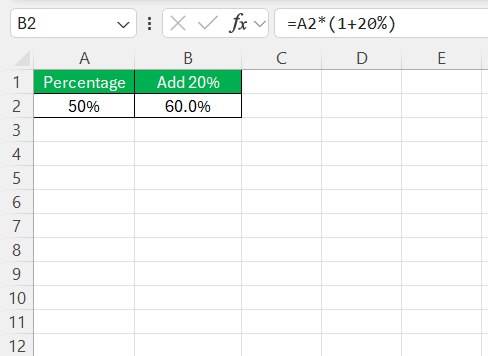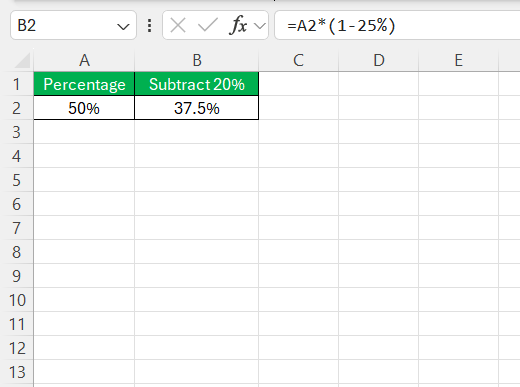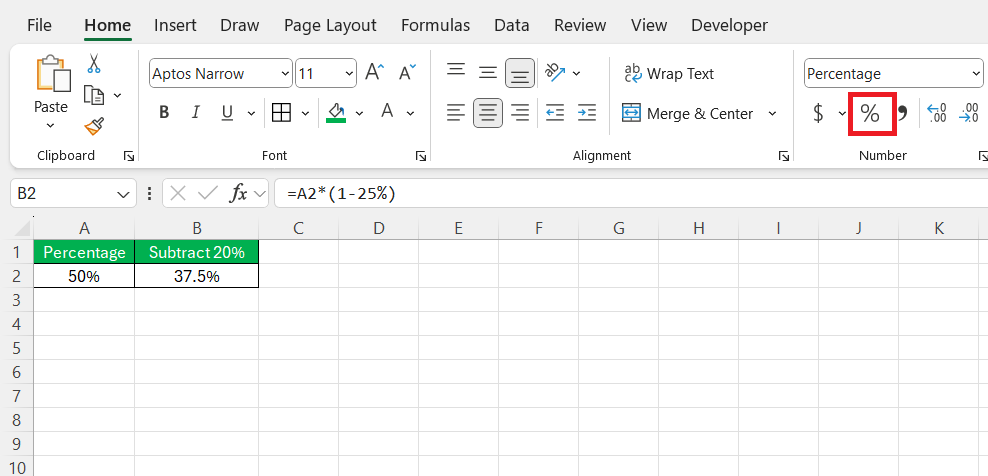When working with percentages in Excel, knowing how to add or subtract percentages can be crucial for accurate data analysis. This article will guide us through simple steps to perform these calculations efficiently, whether you’re adjusting prices, calculating discounts, or analyzing financial data. By mastering these techniques, we’ll be able to handle percentage-based tasks with ease in Excel.
Key Takeaways:
- Understanding Excel’s Percentage Operations: Learn how Excel treats percentages as decimals, making calculations seamless and consistent.
- Basic Percentage Addition and Subtraction: Discover how to quickly add or subtract percentages from numbers using simple formulas.
- Advanced Calculations: Explore methods to increase or decrease entire columns by a percentage and work with negative percentages.
- Real-world Applications: Utilize these techniques for budgeting, financial reporting, and analyzing data with percentage changes.
- Optimizing Calculations: Format numbers as percentages for clarity and avoid common errors by understanding Excel’s order of operations.
Table of Contents
Introduction to Percentage Operations in Excel
The Necessity of Percentage Arithmetic
Calculating percentages is like wielding a Swiss Army knife in the digital world of data. I often find that whether I’m budgeting, presenting sales data, or analyzing survey results, the ability to handle percentages quickly and effectively is indispensable. It’s more than mere number-crunching; it’s about shaping insights and making informed decisions.
Excel’s Role in Simplifying Calculations
Excel stands as the undisputed champion when it comes to simplifying these crucial calculations. It transforms what was once a labor-intensive process filled with manual computations into a sleek, error-minimized affair. With tools and features galore, Excel supports me and countless others in analyzing and visualizing data, enabling us to uncover patterns and stories hidden within numbers.
Understanding Excel Percentages
How Excel Treats Percentage Values
When I type in a percentage in Excel, such as 10%, Excel ingeniously processes it as 0.1, streamlining complex calculations. This automatic conversion basis underpins Excel’s efficiency, where 50% is interpreted as 0.5, and so on.
This aids in maintaining consistency across computations, avoiding frequent misconceptions that occur when manually adjusting numerical values.
Basic Percentage Addition and Subtraction in Excel
Adding a Simple Percentage to a Number
To add a percentage to a number, I harness the simplicity of Excel’s arithmetic. Take a figure in cell A1; I merely multiply it by 1 plus the desired percentage in decimal form. If I’m adding 20%, that’s multiplying by (1+20%) i.e. 1.20.
This method churns out increased values effortlessly, ensuring every addition is both swift and accurate.
Subtracting a Fixed Percentage from a Value
Subtracting a fixed percentage from a value is just as straightforward. If I need to reduce a number by, say, 25%, I simply multiply it by 1 minus the percentage in its decimal equivalent. So for a value in cell A2, I’d use =A2*(1-0.25).
This nifty formula helps me quickly adjust prices, budgets, or any numerical value by a particular percentage rate.
Advanced Percentage Calculations
Increasing or Decreasing an Entire Column by a Percentage
When I’m dealing with extensive datasets requiring uniform percentage adjustments, I find it invaluable to increase or decrease an entire column by a specific percentage. I select the column, apply the desired operation using the fill handle coupled with a simple formula, and watch as all the values update instantly. This powerful capability not only saves time but also ensures consistency across my data.
Working with Negative Percentages and Variances
Working with negative percentages and variances requires a keen eye. In Excel, negative percentages are handled just as positively signed figures are, but with an eye to the context. For variances, I usually calculate the percentage difference between a forecasted and actual figure, keeping a keen eye on negative outcomes to uncover underperformance or areas for improvement.
Real-world Applications for Percentage Adjustments
Preparing Budgets and Financial Reports
As I slice and dice numbers to prepare budgets and financial reports, Excel’s capability to tackle percentages becomes a trusted ally. The platform enables me to earmark funds efficiently by calculating income percentages and allocating them across various expenses. It also allows me to estimate the remaining disposable income after accounting for debt payments, making financial planning more intuitive and grounded in reality.
Analyzing Data with Percentage Changes
Analyzing data with percentage changes in Excel is like peering through a magnifying glass to see the subtle shifts in the business landscape. It aids me in making comparisons over periods or between different entities, lending perspective to growth trends or performance dips. By calculating the percent differences, I bring to light stories the raw numbers tend to obscure.
Tips for Optimizing Percentage Calculations
Formatting Numbers as Percentages for Clarity
I’ve come to realize that clarity is king in data representation. By formatting numbers as percentages, I ensure the data speaks clearly and succinctly.
This approach in Excel transforms decimals that might otherwise be overlooked into bold percentage figures that grab attention and convey precise meaning.
Avoiding Common Errors with Brackets and Order of Operations
Avoiding common errors is pivotal for accuracy in Excel. I make sure to respect the hierarchy of operations by using brackets appropriately, which tells Excel to handle the calculations within them first. This method wardens against misinterpretations and avoids the perils of miscalculations, especially when intricately linking multiple operations.
FAQs
What is the basic formula to add percentages in Excel?
The basic formula to add a percentage in Excel is to multiply the original number by (1 + the percentage as a decimal). For instance, to add 10% to 100, you’d use the formula =100*(1+0.10), yielding a result of 110.
How can I subtract a percentage from multiple cells at once?
To subtract a percentage from multiple cells at once in Excel, input the percentage as a decimal into a cell, say C1. Then, use the formula =A1*(1-$C$1) in the next cell, and drag the fill handle down across all cells to apply the reduction uniformly. This will subtract the percentage in C1 from each cell in column A.
How to subtract a percentage from a number in Excel?
To subtract a percentage from a number in Excel, use the formula =Number*(1-Percentage). For example, to subtract 15% from 200, you would input =200*(1-0.15). This will give you the result after the percentage reduction.
How do you take 20% off a price in Excel?
To take 20% off a price in Excel, I use the formula =Price*(1-0.20). For a $50 item, it’s =50*(1-0.20) which results in a $40 final price after the discount. It’s a straightforward way to calculate discounts or sales prices in Excel.
How excel treats percentages?
Excel interprets percentages as their decimal equivalents: 10% is seen as 0.1, and when I use the percent sign, Excel formats the result as a percentage. This can sometimes lead to confusion if not careful with the formulae, especially in percentage reductions or increases.
John Michaloudis is a former accountant and finance analyst at General Electric, a Microsoft MVP since 2020, an Amazon #1 bestselling author of 4 Microsoft Excel books and teacher of Microsoft Excel & Office over at his flagship MyExcelOnline Academy Online Course.










